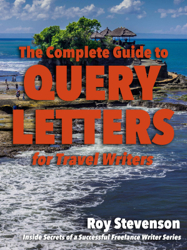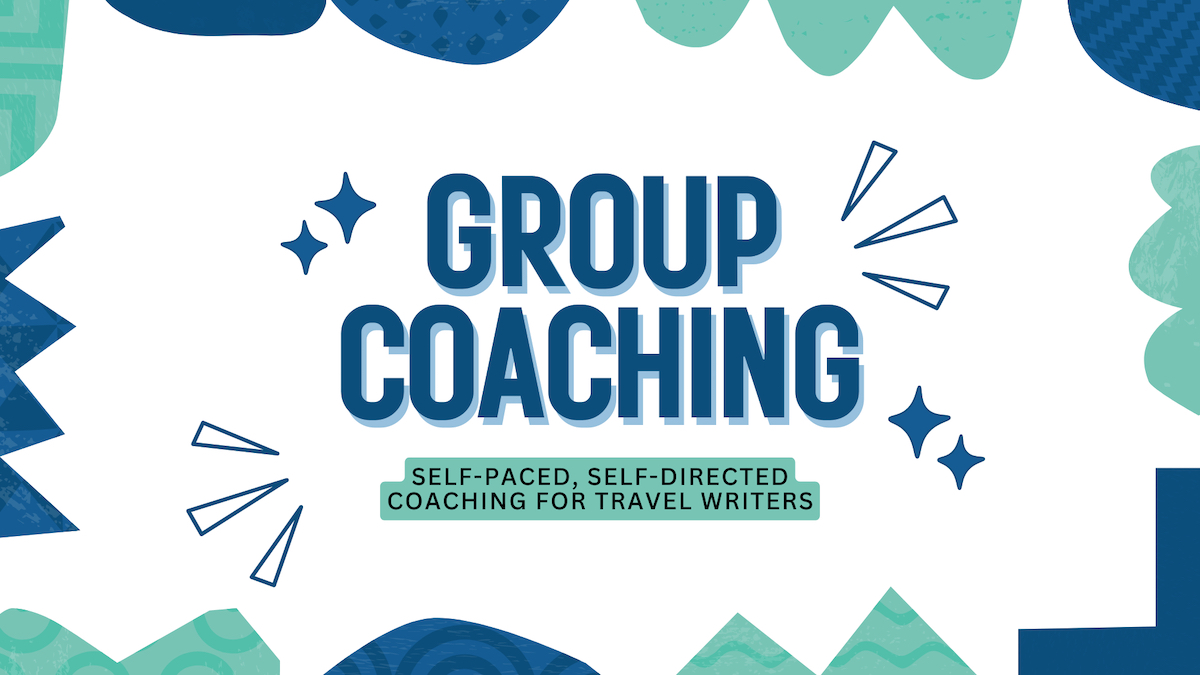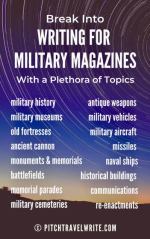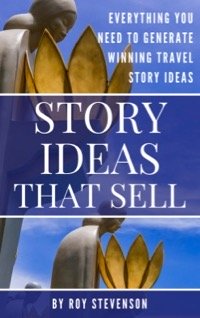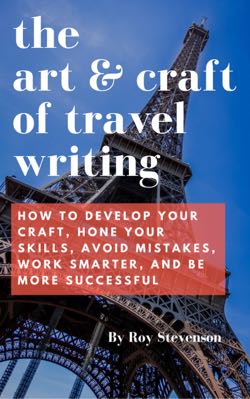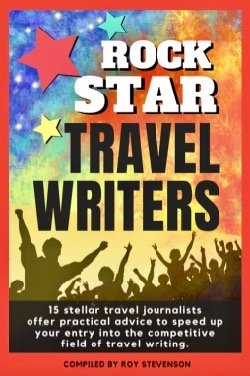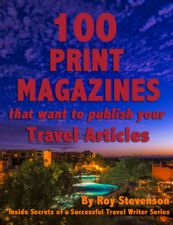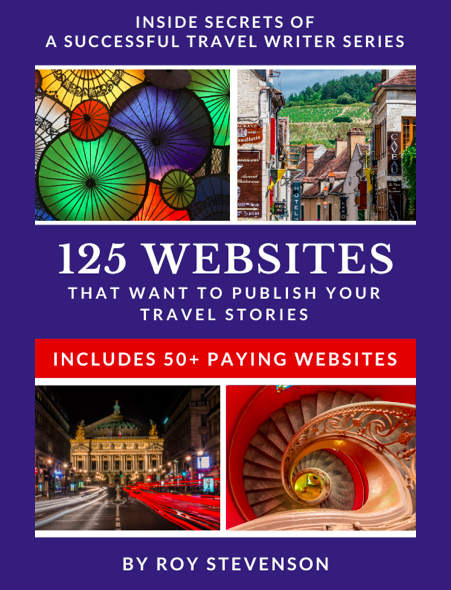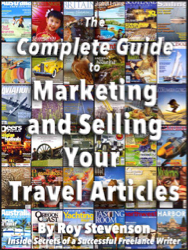- Home
- Getting Published
- Sell your articles more successfully
Five Ways to Sell Articles
More Successfully
By Roy Stevenson
How do you sell articles successfully when you're starting from zero as a travel writer?
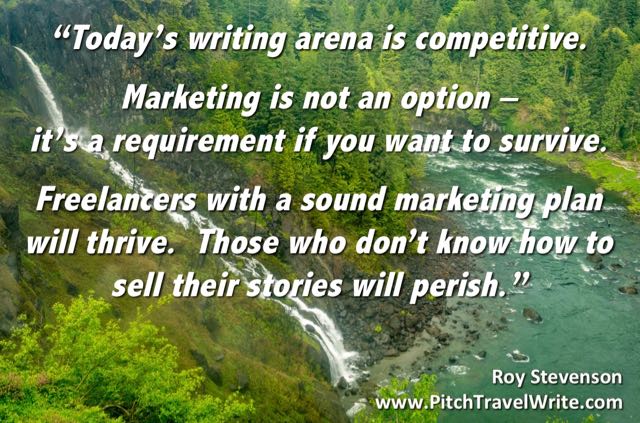
Everyone wants to be a freelance travel writer. It's glamorous. They think our job is easy. Luxury hotels, sandy beaches, gourmet meals, exotic destinations – it seems like a good life, right?
But very few people understand the price we pay for our writing career.
Here's the reality. We stay up late, working to meet deadlines. And we may not get paid much for our articles so we’re always trying to make the most out of every story.
Then there's the most feared part: marketing our ideas to magazine editors. We’re constantly selling our ideas to them. And this inevitably means dealing with rejection - lots of it!
When I tell my colleagues how many articles I’ve sold in the fourteen years I’ve been writing, they look at me in disbelief. (At this writing I’ve sold 1000+ articles in 200+ different publications.)
They ask me how I manage to sell articles so prolifically.
I tell them I spend at least fifty percent of my time on marketing. In my early days of writing I spent as much as 80% of my time marketing my story ideas.
Most writers don’t spend anywhere near this amount of time marketing their stories. Then again, they don’t sell as many stories.
The good news is that email and the internet make it very easy to find magazine prospects and to approach magazine editors.
But, without a marketing plan and strategy, you’ll simply be sending out random query letters and hoping for the best.
Your
prime marketing mission is to cast a wide net and sell articles to magazines that are a good fit for your stories.
Here are five effective ways to do this:
Sell Articles by Studying What
Makes a Magazine Tick
 Statue in Bali Indonesia
Statue in Bali IndonesiaOne way to sell articles and improve your publication rate is to read through a few copies of the magazines that you’re targeting for your sales pitch (your query letter). Grab a recent issue off the rack or check online to see if there are archives of past articles on the website.
Look at everything - articles, editorials and ads.
Who writes the articles? If there are a number of writers listed, the magazine is written primarily by freelancers. If most of the articles are written by staff (whose names will appear on the magazine’s masthead), there’s not likely to be much opportunity for freelancers. Move on.
Read the editorials. This gives you insight into the editor’s preferences. It also gives you a good idea about the tone and personality of the magazine – whether it’s upscale, trendy, adventurous, edgy, budget conscious, and so on.
Look at the variety of topics in the magazine, the average story length, and the style of the articles. Your style will need to match the style of the articles you see.
Look at the ads. This is especially important for travel magazines. Travel magazines sell advertising to destinations mentioned in their articles. Often you’ll read an article and see an ad about that place somewhere within the magazine. If there’s an ad about a destination that doesn’t have a story, it may be an opportunity to pitch a story about that place.
Review the Writer’s Guidelines
Once you’ve determined that a magazine is a good fit for your story idea, go to the writer’s guidelines.
The writer's guidelines will tell you what rate the magazine pays its writers. You want to know before you pitch your article. Then glance at the guidelines to get an idea of what sort of content editor wants.
If the guidelines say the maximum length for feature articles is 1500 words, then pitch a 1500 word article. You don't need to do a in-depth study of the guidelines at this point. Spending too much time on the guidelines before you sell your story idea can be a waste of time.
When the editor says "I'll buy your story" - that's the time to make sure you understand exactly what the editor wants. Usually you'll correspond with the editor for the final details.
Sell Articles by Writing Compelling Query Letters
Once you have a list of your target magazines, it’s time to create and send out your query letters.
Your query letter is your sales pitch. It’s your primary tool to sell articles, and to convince an editor you have a good story idea.
Entire books have been dedicated to the finer details of the query letter. It's a popular topic because it's so vital to your success.
I've written The Complete Guide to Query Letters for Travel Writers. I’ve included 20 actual query letters in my book that worked for me and helped me sell travel stories in a variety of different publications and genres.
It’s important to know how to write a well crafted and compelling query letter. It helps the editor decide whether your story idea is a good fit for his or her magazine - and buy your articles.
Even if you do everything else right, your query letters are what sell your stories. Your query letters are your sales tools. So it’s crucial that you get them right.
Build a Professional Writer’s Website
Having a professional website is a great way to establish yourself as a professional travel writer and prove your credibility to editors who are considering commissioning your articles.
If you’re a beginner, you’ll have to hammer away until you accumulate some bylines, and there’s no easy way to do this except soldier on. Accumulate some bylines and begin listing them on your website.
How many articles should you publish on your website? You’ll need to decide the right number based on the number of genres you write in. I’d say evidence of at least one dozen well-written, published articles gives you some good credibility.
In addition to your writing portfolio, adding testimonials from editors you’ve worked with adds valuable credibility to your website. (I’ve written a separate post about this - see link above.)
Sell Articles by Networking with Editors
Any way you can trot yourself out in front of editors is worth pursuing. Talking face-to-face with editors to find out what kinds of stories they want is an important way to sell articles successfully.
When you find out what editors want, you can start to pitch the right kinds of stories to them.
Where do you find editors?
You’ll often find editors at writer’s conferences. I attend travel writer’s conferences a couple times a year. I've met several editors in person and received assignments as a result.
Writer's conferences are held all over the U.S. and other parts of the world.
For example, one of the regional conferences in the Pacific Northwest is Travel & Words NW Travel Writer's Conference. Regional conferences tend to be smaller and friendlier - and less intimidating for new writers. You can do an internet search for travel writer's conferences in your region.
You can also attend larger conferences like Travel Classics West to find and meet with editors.
When an editor has met you face-to-face, you’re more likely to get your stories accepted. If the editor remembers you as that charming person who chatted them up at a conference in an articulate manner, without being too pushy, you're on your way to establishing a good working relationship.
You can meet an editor by making an appointment and meeting face-to-face in his/her office, if they're local. This isn't always feasible, but sometimes it's possible.
I have lunch with a couple of my local editors occasionally, when I want to discuss my next batch of articles with them. Editors are busy people, but most of them enjoy meeting their writers if you live in the same city.
These are five strategies to help you to sell articles more successfully. All of them are important.
Build these into your marketing plan until they are part of your everyday way of doing business. And before long you will start to see better results.

Roy Stevenson is a professional travel writer and the author of www.PitchTravelWrite.com. Over the past ten years, he’s had more than 1000 articles published in 200 magazines, trade and specialty journals, in-flights, on-boards, blogs and websites and has traveled on assignment around the U.S. and to dozens of international destinations.
IF YOU ENJOYED THIS POST, GET UPDATES. IT'S FREE.
